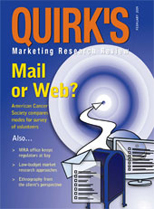Editor's note: This article appeared in the February 25, 2009, edition of Quirk's e-newsletter.
Super Bowl XLII may not have been the year of the up-and-coming, as veteran game advertisers emerged victorious, with Budweiser's spot featuring a Clydesdale competing with a Dalmatian in a game of fetch being named the most-liked and most-recalled ad of the game, according to New York researcher The Nielsen Company. For the eighth year in a row, Anheuser-Busch was the leading advertiser. Additonally, emotional and feel-good ads by Budweiser and Pedigree resounded with women, and men tended to like commercials with more slapstick humor produced by brands like Doritos and Pepsi.
On February 1, 2009, 151.6 million people watched at least six minutes of Super Bowl XLIII, making it the TV event with the largest reach (unduplicated audience) ever. Super Bowl XLIII featured a record-setting amount of network commercial time. Between the opening kickoff and the final gun, Fox aired 45 minutes and 10 seconds of advertising messages - the most ad time in Super Bowl history. Competition in 2009 was especially fierce, with the highest-ever number of motion pictures and non-alcoholic beverage companies vying for likeability and recall, according to New York research company TNS.
Eight different motion pictures were advertised in the game, the largest number of competing messages from any single category. There was also a surge in advertising from non-alcoholic beverages. Six different brands aired spots in the game, an all-time high for this segment. Besides the familiar presence of Pepsi and Coke sodas, there were competing messages for energy drinks (Gatorade; Amp) and flavored waters (SoBe Life; Glaceau VitaminWater).
The lineup of marketers in the Super Bowl game included just five first-time advertisers - the lowest since 2004. Two of these companies (Hershey, Schering-Plough) had previously appeared in the pre-game show and the other three (Bridgestone, Cars.com, Under Armour) were new to the extravaganza.
